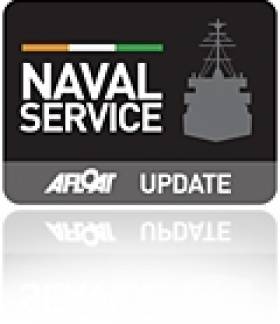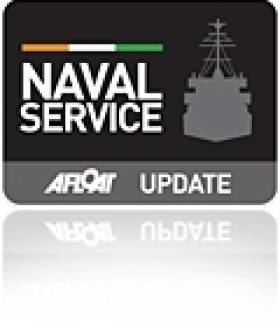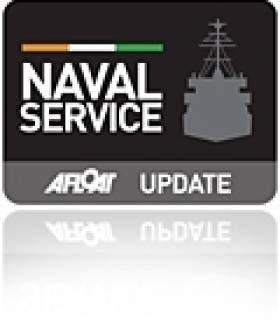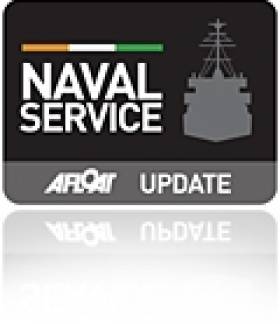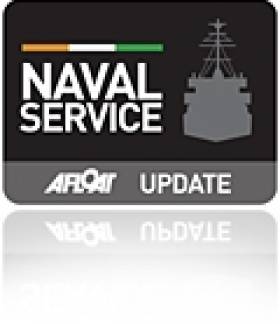Displaying items by tag: LE Emer
Navy’s Retired LE Emer Sold for Role in Niger Delta
#EmerNIGERIA– As previously reported, the former Naval Service vessel LE Emer, which stood down last month after 35 years has been sold to a new owner who says he's unsure on private or security role for the vessel in the Niger Delta.
The vessel was sold at auction in Cork yesterday for €320,000 to London based Nigerian businessman Cyprian Imobhio.
Mr. Imobhio, chief executive and managing director of Uniglobe Group, said he had got the LE Emer, stripped of its armaments, for a good price, but he was reluctant to say it was a bargain. "It was a good price - but I would have preferred to get her for €200,000" he said with a smile.
Speaking following the auction at the Carrigaline Court Hotel in Co Cork where he saw off two rival bidders after bidding rose quickly from an opening gambit of €50,000, Mr Imobhio said he was impressed by the LE Emer when he first saw her at Naval Service HQ at nearby Haulbowline.
For much more on this story, The Irish Times reports.
L.E. Emer Sold to Nigerian for €320,000
#EmerSOLD– A Nigerian company director has brought the former Irish Naval Service OPV L.E. Emer (P21) at auction for €320,000 reports RTE News.
The new owner has yet to decide whether to convert it for pleasure use or use it as a commercial security ship off west Africa. There were two other bidders, one from Cork and the other based in the UK.
Afloat.ie adds that the public auction was organized by auctioneer Dominic J. Daly at the Carrigaline Court Hotel outside Cork City.
The 1978 built 1,019.5 displacement tonnes offshore patrol vessel was last month officially decommissioned following a ceremony held in Cork City quays attended by Flag Officer Commanding the Naval Service Cmdr. Mark Mellett.
She subsequently returned to the Naval Service basin on Haulbowline Island where she was made open for inspection by potential buyers.
Her final patrol having taken place in late September which took in farewell calls among them to Dublin Port and a special cruise for former crew.
A pair of Pielstick 6-cylinder Diesels powered the ship over a distance of approximately 518,000 miles during the course of a career spanning 35 years.
According to the auctioneer, L.E. Emer's nearest sister L.E. Aoife (P22) which was completed only two years later and also launched at Verolme Cork Dockyard (V.C.D.) is to be put on the market in a year's time.
The design origins of L.E. Emer derive from the Naval Service's first custom-built vessel the L.E. Deirdre also launched from the V.C.D. shipyard in 1972 at Rusbrooke near Cobh. She was decommissioned in 2001 and sold for €190,000 and converted into a luxury yacht.
This will eventually leave the final 'Emer' class member L.E. Aisling (P23) to remain in the current seven-strong fleet. A pair of replacement newbuilds of the enhanced 'Roisin' or PV90 class are on contract from Babcock Marine.
The first newbuild L.E. Samuel Beckett (to be floated-out next month) in Appledore, north Devon is to be delivered early next year. Her sister L.E. James Joyce is scheduled to enter a year later in early 2015.
A Flying Send-Off as L.E. Emer Bids Dublin Bay Farewell
#FarewellEMER - Today the sell-listed L.E. Emer (P21) departed Dublin Port for the final time and it was also the Naval Service OPV's last patrol, writes Jehan Ashmore.
She headed out of Dublin Bay under the command of Lt .Cdr. Alan O'Regan and where she set a southerly course to pass the Muglins off Dalkey Island.
At the same time of her late morning exodus of the bay, a former World War II serving Catalina flying-boat soared above. The distinctive aircraft was heading eastwards over the Irish Sea, having taken part in yesterday's Flight Fest hosted in the capital.
L.E.Emer is scheduled to complete her patrol duties next Friday at the Naval Base in Haulbowline, Cork Harbour.
She will be decommissioned and next month put up for public auction unless previously sold. A pair of replacement OPV newbuilds are under contruction in the UK with the first of the improved 'Roisin' class due for delivery next year.
L.E. Emer Takes Capital Centre-Stage Berth at Flight Fest Feast
#FlightFest – L.E. Emer's (P21) last large-scale public duty in Dublin Port took place at yesterday's Flight Fest flyover spectacular which according to organisers drew around 130,000 spectators, writes Jehan Ashmore.
The Naval Service's eldest fleet member was built by Verolme Cork Dockyard in 1978 and she berthed at North Wall Quay in front of the impressive backdrop of the National Convention Centre.
Tours were available onboard the sell-listed OPV on what would be the last such opportunity during her visit to the capital. Today she resumed her final patrol duties scheduled to end this Friday in Cork Harbour.
Adjoining the Convention Centre is the PWC building which was where a dedicated air-traffic control team placed in charge of the 30 plus aircraft of all shape and sizes that flew low over the length of Dublin Port and 'Docklands' quarter.
As previously reported among the participating aircraft were a pair of Air Corps CASA fishery patrol planes of the maritime squadron which flew in close formation with PC9 aircraft also drawn from the air-wing of the Irish Defence Forces.
As well as the World War II Catalina Flying-Boat with its distinctive design which could be easily identified from quite a distance as she loomed over the Liffey to the crowds delight.
Onlookers not only filled the city-centre quays but also thronged another Irish built vessel, T.S.M.V. Cill Airne which was chartered out for a private function.
The riveted hull veteran represents another rare example of an Irish built ship surviving on our shores. In this case the former Cobh-based transatlantic liner tender was built locally at the Liffey Dockyard more than a decade earlier than the L.E. Emer.
These days Cill Airne has a purely static role as she is moored as a floating river-restaurant, bar and lounge venue which was particularly well patronised during the Flight Fest that saw aviation and shipping converge.
Retiring L.E. Emer to Launch Flight Fest Spectacular Featuring Marine-Related Aircraft
#FlightFest – L.E. Emer (P21) as previously reported will officially launch tomorrow's Flight Fest spectacular above Dublin Port and she will be open to public tours before retiring with less than a week to go, writes Jehan Ashmore.
The eldest member of the Naval Service fleet is berthed at North Wall Quay which is downriver from the Samuel Beckett swing-bridge which will not be accessible for vehicles but kept open to plane-watchers.
Organisers of the festival involving street events starting 12 noon, suggest the best vantage points to view more than 30 aircraft in the flyover (13.50hrs-17.00hrs) are along both sides of the Liffey quays of the city-centre 'Docklands' quarter.
The quays will be pedestrianised between Custom's House Quay to the East Link Toll Bridge on the northside, and from Georges Quay to the end of Sir John Rogerson's Quay on the southside.
The impressive 'Gathering' of aircraft include planes representing each decade stretching back to the 1930' s. They are to be flown at a mere 800 feet (rather than the norm of 1,700 feet) as they approach on a special flight-path corridor than runs on a East-West direction, i.e. from Dublin Bay and over the port entrance and city-centre.
Among the great line up of historic World War II aircraft will be a Catalina flying boat that served from Lough Erne in Co. Fermanagh.
In addition the Aer Corps CASA patrol craft of the Marine Squadron, that monitors fishing vessel activity and where information is relayed to Naval Service headquarters at Haulbowline, Cork Harbour.
The Naval Base is where the L.E. Emer will be arriving next Friday on completion of carrying out her final patrol duties. She is to be de-commissioned and put up for public auction next month.
The FlightFest will also feature the important role of the Irish Coast Guard's life-saving helicopters of the Sikorsky S61 and S92 designs.
For a complete list of the flyover involving aircraft from civil, private and the military and notably the giant Airbus A380 from British Airways, visit this link For general information visit: http://flightfest.ie/faqs
Flight Fest Flyover Above Dublin Port Sees Return of ‘Farewell’ L.E. Emer
#FarewellEMER – This Sunday's spectacular Flight Fest Flyover above Dublin Port and city-centre quays is from where the event is to be officially launched by the LE. Emer (P21), writes Jehan Ashmore.
The return to Dublin Port of the sell-listed Naval Service offshore patrol vessel follows a recent call to the capital only last week. On that occasion she made a special farewell cruise in Dublin Bay for former sailors.
So it transpires that this visit to Dublin Port is in fact likely to be her 'final' call to the capital while also performing her last patrol duties.
The 1978 built veteran is to decommission on 20 September and if not previously sold the 65.5m long vessel is to go for public auction next month.
L.E. Emer Makes Farewell Patrol ‘Cruise’ in Dublin Bay
#FarewellEMER – L.E. Emer (P21) has completed a four-hour farewell patrol 'cruise' in Dublin Bay today for former crew members of the 1978 built vessel, writes Jehan Ashmore.
The Naval Service offshore patrol vessel (OPV) had on board both members of the The Naval Association and Merchant Navy and where no doubt numerous naval career stories were recalled down through the years.
She slipped her moorings this morning and departed Dun Laoghaire Harbour and made a clockwise circuit of Dublin Bay, passing the Baily Lighthouse, rounding the North Burford bouy and then proceeded south before reaching off Killiney Bay.
In calm sunlight seas she stayed in these waters before slipping through Dalkey Sound to Scotsman's Bay and off Sanycove Point, she also momentarily took some time there before she headed to dock in Dublin Port just after lunchtime.
At the next berth is the French Navy's mine-warfare vessel Croix du Sud which arrived this morning.
Yesterday, L.E. Emer made the short passage from an anchorage call off Skerries to Dun Laoghaire Harbour where tours of the vessel were made to the public while berthed at Carlisle Pier.
As previously reported, L.E. Emer is to be de-commissioned on 20 September and in the following month a pubic auction is to take place to sell the 35 year veteran unless previously sold.
L.E. Emer to Make Final Farewell Visit to Dun Laoghaire Harbour
#FarewellEMER – L.E. Emer (P21) the oldest member of the eight-strong Naval Service fleet is to make her final scheduled visit to Dun Laoghaire Harbour tomorrow, writes Jehan Ashmore.
As previously reported, L.E. Emer is making her final patrol before she de-commissioning on 20 September. The offshore patrol vessel (OPV) will go for sell unless previously sold at a public auction to be held on 23 October. A sister, L.E. Aoife (P22) will likewise be disposed a year later.
Tomorrow (Sunday) afternoon L.E. Emer will be open to public tours while she is berthed alongside the Carlisle Pier. As previously reported the five-masted cruiseship Wind Surf is today docked at this same pier having sailed from Portrush via the Isle of Man.
Potential interest for the naval vessels could include the conversion of the ships for the superyacht market or use for the offshore energy supply sector or a research vessel.
They are to be replaced by a pair of larger 'Roisin' class OPV's currently under construction by Babcock Marine in Appledore, north Devon.
L.E. Emer was completed in 1978 followed by L.E. Aoife in 1980 at the Verolme Cork Dockyard (V.C.D.). Also launched from the shipyard in Rushbrooke near Cobh, the youngest sister L.E. Aisling (P23) which will remain in service.
As leadship of a trio of 'Emer' class Coastal Patrol Vessels (CPV) the series however in more recent years were re-classified as Offshore Patrol Vessels.
They are an improved version of L.E. Deirdre (P20) which was the first custom-built vessel for the Naval Service when launched from V.C.D. in 1972. She was de-commissioned in 2001 and sold for €190,000 and converted into a luxury yacht.
#navy – Cork Auctioneer Dominic Daly is to sell the Navy Vessel LE Emer (P21) in early October. The Auctioneer, who recently handled the public auction of the Clipper Faith Cargo vessel for the Admiralty Marshall, confirmed arrangements are now in place with the Department of Defence to dispose of the ship this Autumn. Interest could come from a variety of sources including the conversion of the ships for the superyacht market or use as an offshore energy supply boat or a research vessel.
A year later the sister ship LE Aoife (P22) will also go on the market. Both ships are being replaced with new builds for the Irish Naval Service.
As Afloat.ie reported in May, the two Irish-built navy patrol ships launched at Verolme Cork Dockyard, are to be sold off after 40 years of service.
LE Emer (P21) and a sister ship LE Aoife (P22) were built between 1978 and 1980 at the Rushbrooke shipyard near in Cobh, Co Cork.
The first ship of four in the Offshore Patrol Vessel (OPV) class built in Cork in 1972, the LE Deirdre (P20) , was decommissioned in 2001 and sold for €190,000. She was later converted into a luxury yacht.
The two ships will be replaced by two new OPVs currently under construction in the UK.
Fishing Vessel Detained off South-East Coast
#NAVY– The Naval Service has detained a fishing vessel off the south-east coast over alleged breaches of fishing regulations, reports the Irish Examiner.
The L.E. Emer (P21) detained the Irish-registered boat around 19 nautical miles from Mine Head in Co Waterford yesterday evening.
The vessel was escorted to Cork and handed over to Gardaí in the early hours of this morning. More than 1,200 boardings and 17 vessels have been detained by the navy so far this year.


























